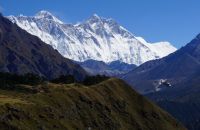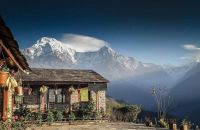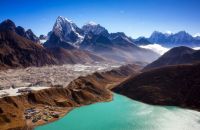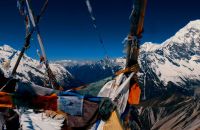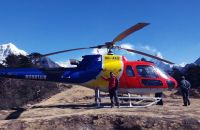Talk with our local travel specialist who can help organize your trip.
What training do you need for Everest Base Camp?
Trekking to Everest Base Camp, the highest trekking destination in the world, is a once-in-a-lifetime experience for any hiker. The high-altitude trekking experience is fraught with many hazards, but the thrill of walking to the base of the world's tallest mountain, Mount Everest, is at a whole new level.
Like any mountain adventure, the trek to Everest Base Camp also needs a lot of planning. You need to physically and mentally train yourself to make it through the high-altitude zone. You need to know what altitude sickness is and how to deal with it and avoid it while on the trail.
So, what training do you need for Everest Base Camp? Here are some tips on how you can train yourself for your trip to Everest Base Camp.
But before we start, where in the world is Everest Base Camp?
Table of Content
Where is Everest Base Camp?
Everest Base Camp lies at the base of the world's tallest mountain, Mount Everest, in South Asia. There are two EBCs, one on the north or Tibet side and the other on the south or Nepal side. While there's road access to Everest Base Camp on the north side, one has to trek all the way to the base camp from Lukla or Jiri to reach the south side of Everest Base Camp. The trek to Everest Base Camp in Nepal is one of the most sought-after walking adventures in the world. The trek is regularly featured in the list of top ten hikes or adventures in the world by renowned travel and adventure guides like National Geographic, Lonely Planet, and Condé Nast Traveler.
The Everest Base Camp trekking trail in Nepal lies in the Everest or Khumbu Region, in the northeastern part of the country. The EBC trail winds past the foothills of some of the world'shighest mountains, as well as Sherpa villages. The trek not only offers an incredible mountain adventure but a peek into the lives of the Sherpas, the sturdy mountain-dwelling tribe famous throughout the world for their climbing acumen.
What training do you need for Everest Base Camp?
If you are planning to trek to Everest Base Camp, then you will need to be physically fit and healthy. The trek to Everest Base Camp takes you to elevations of 5000 meters, and each day's trek lasts for about 5 or 6 hours. The trail is steep, and there are lots of ups and downs. Often, there are switchbacks and crossings over high-suspension bridges.
As you cross the 3000-meter mark, you will find the oxygen in the atmosphere depleting, and this will make breathing difficult. The final stretch, from Lobuche to Everest Base Camp, could be the toughest for you, as you will have to hike from Lobuche to EBC via Gorak Shep. If you plan to hike to Kala Patthar (5545m) viewpoint then that’s going to be the toughest challenge during your trek
The thin air makes the trek more difficult. Prior to reaching EBC, you will have to ascend hills and steep mountain paths and stay at Sherpa villages. The total distance covered during the Everest base Camp Trek is 130 km (round trek from Lukla), and the total altitude gain is 2504 m (if you start your trek from Lukla).
To make it to Everest Base Camp, which lies at an elevation of 5364 meters, you need to be physically as well as mentally fit. Here's how you can go about training your mind and body to complete this grueling high-altitude challenge.
Featured Trips
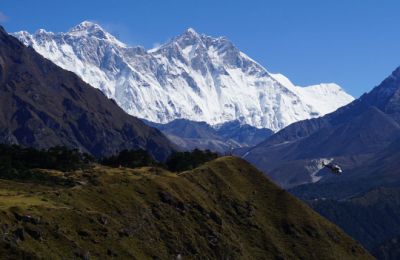
Everest Base Camp Trek - 14 days
Looking for an exciting Himalayan experience? Join us on our 14 day Everest Base Camp Trek - get ready to be stunned by breathtaking views and discover magical Nepalese cultures!
Inquire Now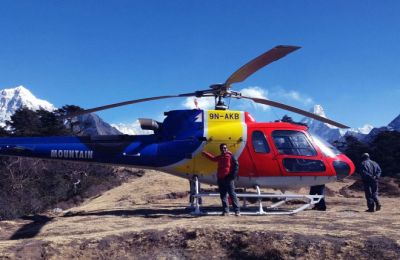
Everest Base Camp Luxury Trek with Helicopter Flight - 11 days
Take an extraordinary journey and explore majestic Mount Everest with a once-in-a-lifetime Everest Base Camp Trek. Enjoy the sights of local Sherpa culture along the way before soaring back down to Kathmandu in a helicopter return.
Inquire NowWhere to travel next?
Get help from our travel specialists for holiday ideas that matches your interests.
Go on Hikes
There's no better way to train for your trek to Everest Base Camp than by going on long hikes. You can go hill hiking and choose terrains that are steep and rocky and include some grueling ascents. Carrying a heavy backpack with you while hiking will increase your endurance and help you when you walk through the actual trails of Khumbu. If there are no hills around where you stay, then you can go for long walks in your neighborhood or climb the staircase of your apartment building if you live in a multi-storied apartment building.
Build up your Stamina
When you walk on the high EBC trail, one step will be equivalent to taking six steps at sea level. Your body should have enough stamina to walk 6 to 7 hours daily without getting too tired. So which exercises help you build up your stamina? The answer is intense cardio exercises.
Your training program for the Everest Base Camp Trek should include some high-intensity cardio exercises. The aim of these exercises should be to elevate your heart rate for forty-five minutes to an hour. This will improve your cardiovascular system in your body, which in turn will produce more oxygenated blood in your system. If there's more oxygenated blood in your body, you won't get tired easily.
Running, swimming, rowing, and cycling are some high-intensity exercises that can elevate your heart rate. This improves your breathing capacity and strengthens your heart and lungs. In high elevations, people tend to get tired easily due to low oxygen levels. When you have a strong heart and lungs, you will be able to walk long distances without overexerting yourself. Building up your stamina will help you realize your goal of reaching Everest Base Camp without any mishaps.
Strength Building
Muscle strength is really important when you trek for multiple days at high altitudes. While tackling the steep ascents and descents, the weight of your bag and body is supported by your shins, knees, shoulders, and abdomen. If your muscles are not strong, you will feel tired soon, and you will get muscle cramps. To develop your muscle strength, you need to lift weights, do leg raises, and do exercises to develop your calve muscles and also build up your muscle strength in your lower body.
Additionally, do deadlifts to strengthen your hamstrings, quadriceps, and thigh muscles. This will increase the strength of your legs. Workouts for your glutes and hip flexors are also necessary. You can strengthen your legs and lower back by doing numerous sets of squats, lunges, glute exercises, step-ups, step-downs, and other exercises.
Flexibility
Include stretching exercises in your training regimen to increase flexibility in your muscles. Building up your muscle flexibility also helps you avoid muscle cramps or injuries while trekking.
By incorporating stretching exercises into your daily routine, you will be able to increase your body's flexibility and range of motion. Do sets of different yoga poses or Pilates before and after any intense workout or activity. Even while on the trail, you can start your day with stretches and lunges that will open up your muscles and prevent any muscle tears due to exertion. Butterfly stretch, lunging hip-flexor stretch, cobra pose, standing-quad stretch, etc. are some of the stretching exercises that will increase your flexibility.
Breathing Exercises
The Everest Base Camp Trek leads you to places where the atmosphere has only fifty percent oxygen. The air in Khumbu is thinner and has less oxygen than it does at sea level. For people who have lived at low elevations, it gets harder to breathe at high altitudes. Making an effort to learn breathing methods will help you during your trek. It will enlarge your lung capacity and help you combat breathlessness.
Breathlessness and exhaustion are common side effects of high-altitude trekking. Learning the breathing technique of "pranayama," a yoga breathing method, will be very beneficial for your high-altitude hike. Pranayama, or deep breathing exercises, will improve your blood circulation and regulate your body temperature.
Practicing belly breathing, alternate nostril breathing, and forceful exhalations every day will help you increase the oxygen supply in your body and improve your lung capacity.
Eat Right
Your training regimen is incomplete without a balanced diet. What you eat, when you eat, and how much you eat daily matter a lot in preparing your body for the Everest Base Camp Trek.
You will never get the optimal result, even with a rigorous fitness schedule, if your diet is not healthy. So your focus while preparing for your trek should also be on your diet—having the right food and the right amount of food at the right time.
Your diet should be nutritious and well-balanced. Cutting down on sugar and carbs and increasing your intake of protein and mineral-rich foods helps a lot in building up your muscle strength. Include green leafy vegetables, dairy, fresh fruits, dried fruits, and nuts in your daily diet. Stay away from junk or fried foods, and keep your snack options healthy. Also, have your meals at a fixed time and refrain from overloading your belly with excess food.
Boost your immunity
The high-altitude environment is bound to weaken your body and make you prone to illnesses like the common cold, flu, cough, diarrhea, or AMS. Since this is a popular trek, many trekkers do this trek, and they come from every part of the world. They bring with them germs and other bugs from their home country.
In addition, the food preparation standards in some of the rustic teahouses and hygiene can be quite low. Extremely low temperatures, dusty trails, and unhygienic communal restrooms can all lead to some of the illnesses mentioned above. If you have a good immune system, you will be able to combat all the disease-causing germs. You can boost your immune system by eating a balanced diet and making sure your body has all the required vitamins and minerals.
A good immune system will reduce your chances of getting sick while trekking. You can combat any mild infections and disease-causing bacteria with a robust immune system. To build up your immune system, have a nutrient-rich diet.
Make sure your diet is protein-rich (meat, dairy products) and has an abundance of fresh vegetables and fruits. Stop eating processed foods and fast food. Having a diet high in protein will help you build muscle mass. To protect yourself from respiratory infections and the common cold, load up on zinc, magnesium, and vitamin C and D supplements.
Test your hiking boots and other equipment
Before the start of your trek, you can try out your equipment and break in your hiking boots. Start wearing the new pair of hiking boots you will be wearing during your trek inside your home. Wear them with the socks and insoles you will be using during your trek. Gradually, you can try on your boots when you go for long walks and hikes.
There's nothing more painful on a multi-day hike than an ill-fitting pair of boots that pinches and makes your feet all sore. So, it's important to break in your new pair of hiking boots before the start of your trip instead of trying them out on the trail and hobbling around painfully.
While selecting the right boots for your trek, choose one that is lightweight, comfortable, has good traction, and is waterproof. Also, test your daypack and find out whether it's sturdy enough to carry the weight you plan to carry for multiple days without wear and tear. Try out your trekking poles and hydration backpack (if you plan to carry one) while going on hikes.
Featured Trips
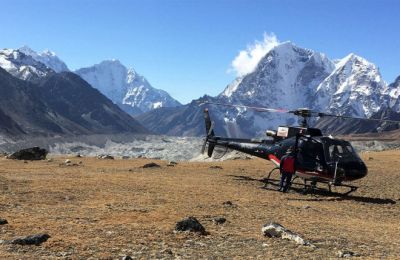
Everest Base Camp Helicopter Tour - 1 day
If you are seeking a thrilling helicopter experience and want to see the best of the Himalayan range and witness Mt. Everest, then book now for a journey to the Base Camp of Everest.
Inquire Now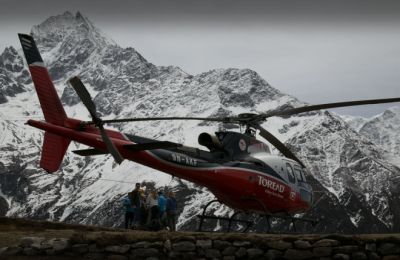
Everest Base Camp Gokyo Lakes Helicopter Trek - 8 days
Enjoy Everest Trek like never before with Everest Base Camp Gokyo Lakes with helicopter returns 8 days. Trek to EBC and spectacular flight over Gokyo Valley.
Inquire NowWhere to travel next?
Get help from our travel specialists for holiday ideas that matches your interests.
When should you start training for Everest Base Camp?
You can start training for your trek as early as possible. If you have time start your physical prep six months in advance. You should train for at least three or four months before your scheduled departure to Nepal, The longer you train, the fitter and more prepared you will be for your trek. It takes time to build and develop muscle strength and stamina. So if you start your training regimen a few months in advance, your body will be prepared to tackle the harsh and challenging environment.
Apart from the above-mentioned tips, these points are also crucial to making your trip a success.
Rest Days for Acclimatization
Your itinerary should have acclimatization days that allow you to rest and adapt your body to thin air. Usually, trekkers take their acclimatization break at Namche and Dingboche before heading further up to Everest Base Camp. Staying an extra day at a lower elevation will allow your body to adapt to the low oxygen levels in the atmosphere. Hiking up straight to high altitude without taking acclimatization breaks in between will result in AMS or altitude sickness. The severe forms of altitude sickness include HACE (high-altitude cerebral edema) and HAPE (high-altitude pulmonary edema), where swelling occurs in the brain and lungs and can be fatal if not treated on time.
Right Clothing and Gear
Remember, you will be walking under the foothills of the world'shighest mountains, crossing glaciers and river valleys. It will get colder the higher you reach. It's important to pack clothes that will keep you warm even at temperatures below zero. In Lobuche and Gorak Shep, the highest places where you will stay overnight, nighttime temperatures dip below the freezing point.
Make sure to pack down jackets and warm thermals or layers that will help you combat the icy wind and freezing temperature. While the teahouses provide a bed with blankets or quilts, you may need a sleeping bag to keep you warm and cozy during the night, as houses in the mountains do not have central heating. Also remember to pack warm gloves, mittens, woolen socks, a balaclava or scarf (to keep out the fine dust), a cap, or fleece-lined hats.
Staying Hydrated
During your trek, drinking lots of fluids will help your body fight off the symptoms of altitude sickness. Dehydration is one of the causes of AMS. While on the trail, you should always remember to carry a water bottle and drink a few sips of water at regular intervals, even if you are not thirsty. Drinking ginger tea, sea buckthorn tea, and Sherpa garlic stew also helps in minimizing the effects of AMS.
Get the right travel insurance
Ahigh-altitude trekking adventure is risky, and there's no telling what's in store for you even when your planning is immaculate. One can never predict the weather or natural calamities that can occur in a mountainous environment. So it's better to have a safety net and buy the appropriate travel insurance before the start of your trek.
Please make sure that you buy a policy that has coverage for high-altitude accidents and air evacuations above 5000 meters. Most travel insurances do not have high-altitude rescue coverage, so you need to read the fine print and make sure that high-altitude helicopter rescues are included in your insurance policy.
Do your research
It's important to have some knowledge of the destination you are traveling to before you embark on your trip, especially if you are heading to the mountains. You need to have some understanding of the terrain you will be walking on.
Even though the Everest Base Camp Trek takes you to one of the remotest corners of the globe, there's enough information about the trek available. You can use digital media to find out more about the trail or pore over trekking journals or guidebooks to get an idea of the trail. You can watch travel vlogs put up by YouTubers who have documented their trek to EBC or video documentaries about this famous trek. The Everest Base Camp Trek is one of the oldest and most popular treks in Nepal, and there's no dearth of information about this trek.
If you book your Everest Base Camp Trek with Third Rock Adventures, we will provide you with a trip dossier or a travel guide where you can find useful information about your EBCitinerary, trekking route, nutrition, accommodation, training tips, packing list, etc.
Conclusion
The Everest Base Camp Trek is a strenuous high-altitude trek that takes you under the shadows of 7000 and 8000-meter peaks. It's a slow-paced trek that takes about fourteen or sixteen days to complete. If you are in better shape, you will be able to enjoy our trek to the fullest. To be in good physical shape, you need to train regularly for at least three months before the start of your trip.
If you are better prepared and have put in the hard work, then you won't suffer on the trail and will fully enjoy your trek. The best way to motivate yourself to start training for your trek is to sign up for a trek and book your slots with an agency. If you plan on doing it independently then you can start booking your air tickets and accommodation. Once you have a fixed plan and an itinerary to follow, you will automatically feel the need to push yourself and prepare for your trip (maybe hit the gym or go on long hikes).
So if you are mulling over the idea of trekking to Everest Base Camp, we urge you to book your trek right away. There's no better time than now to book your trip and start training for Everest Base Camp. If you have been confused about what training you need for Everest Base Camp, I hope the above-mentioned tips have shed some light on how you can go about training for the highest trek in the world. Wish you good luck with your training session, and see you soon in the Himalayas!
- Written by: Naba Raj Amgai
Updated: Jun, 13, 2024





